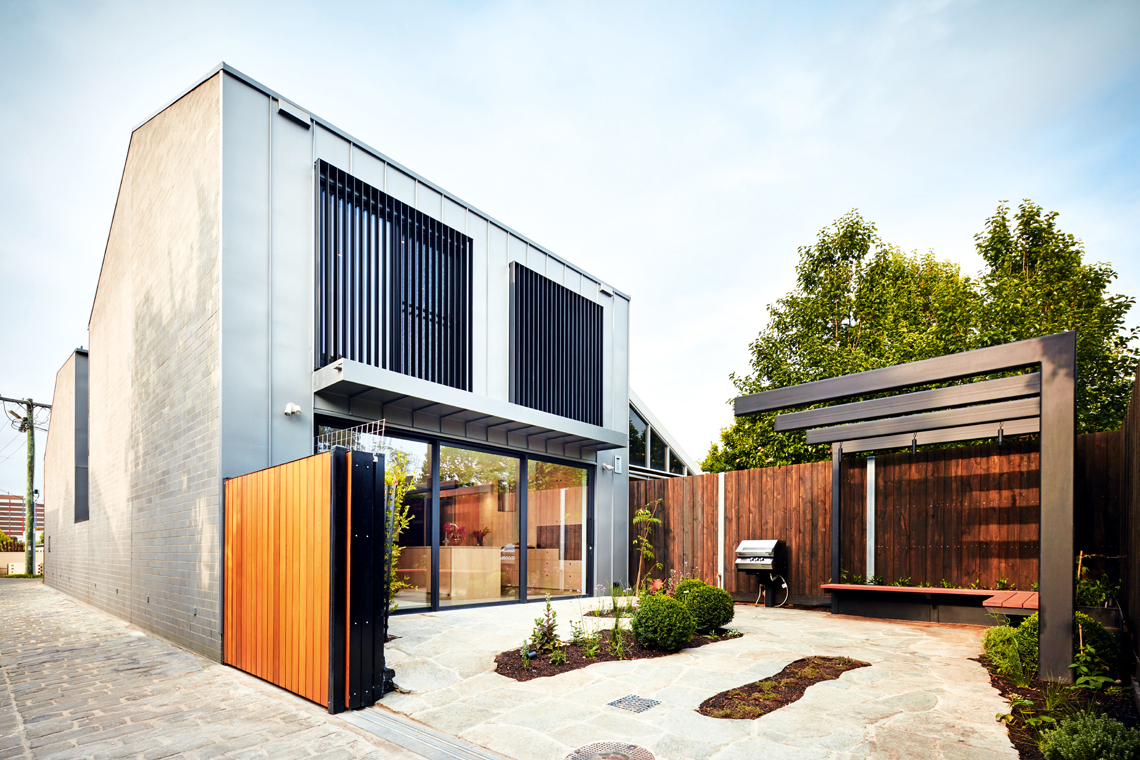The expression “good things come in small packages” feels especially fitting for this new build: a four-bedroom, two-office, four-bathroom home in Hawthorn, Melbourne. At first glance, you might mistake it for a pokey, one-storey city dwelling with a contemporary exterior. However, you’d be gravely mistaken. Behind its pocket-sized, stoic exterior, this metallic masterpiece unfolds into a home of depth and detail, offering space-enhancing sophistication that gradually reveals itself throughout the journey.
“The clients’ brief to the architect was that they wanted ‘a little, modern house,’” explains Fiona of Fiona Drago Architect, the mastermind behind the design. “They planned to downsize from their large family home to a more compact house in a central location, which could be shared with their children as they grew.” As the design process unfolded, however, this brief quickly evolved into a call for ample space, light, and abundant storage. Achieving this was no small feat, especially for a 189sqm block with a dilapidated skeleton.

The plot has unique features worth noting. First, it’s located on the corner of a quiet street and a laneway. This allows it to sit comfortably on a site slightly wider than a standard terrace house. As a result, Fiona’s team designed a double-fronted home with a cool tandem arrangement tucked behind the exterior. “The two masses are separated by a courtyard,” Fiona explains, “which not only allows natural light into the center of the house but also extends down to the basement.”
According to homeowner David, the house is “like an iceberg house on steroids,” which makes sense due to the hidden space beneath the peak. In the basement, you’ll find a spare bedroom, gym, wine cellar — capable of housing 1000 bottles — office, bathroom, and subterranean courtyard.
The basement allows its inhabitants to live in harmony, with each person having their own space, a feature especially valued during Melbourne’s COVID-19 lockdown. “Everyone set up their office work areas,” says David. “It was amazing. We would gather in the kitchen/living area at night, and for a change of scenery, we’d head to the rooftop for a cocktail.”

Inspiration for the new design came from what already existed, and the home needed to align with others on the street. To achieve this, Fiona explains, “The design takes inspiration from the neighbouring terrace houses,” reflecting their single-storey scale and pitched roof forms. As a result, the house appears single-storey from the street. Furthermore, the zinc cladding and grey masonry blocks reflect the neighbouring homes’ brick walls and metal roofs. Their grey colour also mirrors the bluestone laneway. Additionally, the zinc cladding wraps up the wall and over the roof, highlighting the building form of a typical terrace house.
Creating this masterpiece, however, did not come without its challenges. The previous home on the site had been gutted in a 1970s renovation, meaning original walls and structures were removed. When Fiona’s team arrived, the building was completely dilapidated. Moreover, an unstable adjoining house posed a serious concern. “There was trepidation for us as owners and for Vivian, our neighbour who shares a boundary wall, during the excavation period,” explains David. “Vivian’s house was sitting on poor-quality 100-year-old lime mortar mix foundations. Everyone was fearful of Vivian’s house collapsing into the huge hole that ran along the adjoining boundary and the full length of her house.” Fortunately, extensive underpinning tackled this problem, securing the neighbour’s property without catastrophe.

And given the proximity of Vivian’s home, sound retention was also of utmost importance. “All the service rooms (bath, kitchen, laundry, stairways etc) are between the corridor and the neighbour’s wall,” explains Fiona, “while all the bedrooms and living areas are located on the laneway side to benefit from the available natural light”.
The resulting grand design is magnificent in so many ways. It’s a truly well-considered masterpiece that faced a real challenge for space. With clever design strategies and exceptional Tetris-like thinking, the space reveals itself both above and below deck.
“From the moment you open the front door and start walking through the house, you discover a series of light-filled spaces that are such a surprise considering the house looks like a single-storey terrace from the street,” concludes David. “The seamless connection from the main living area to the garden is also wonderful. Our son and daughter have their own zones within the house and they say that they won’t ever be moving out!” This house really is that good.
Photography: Rhiannon Slatter

















